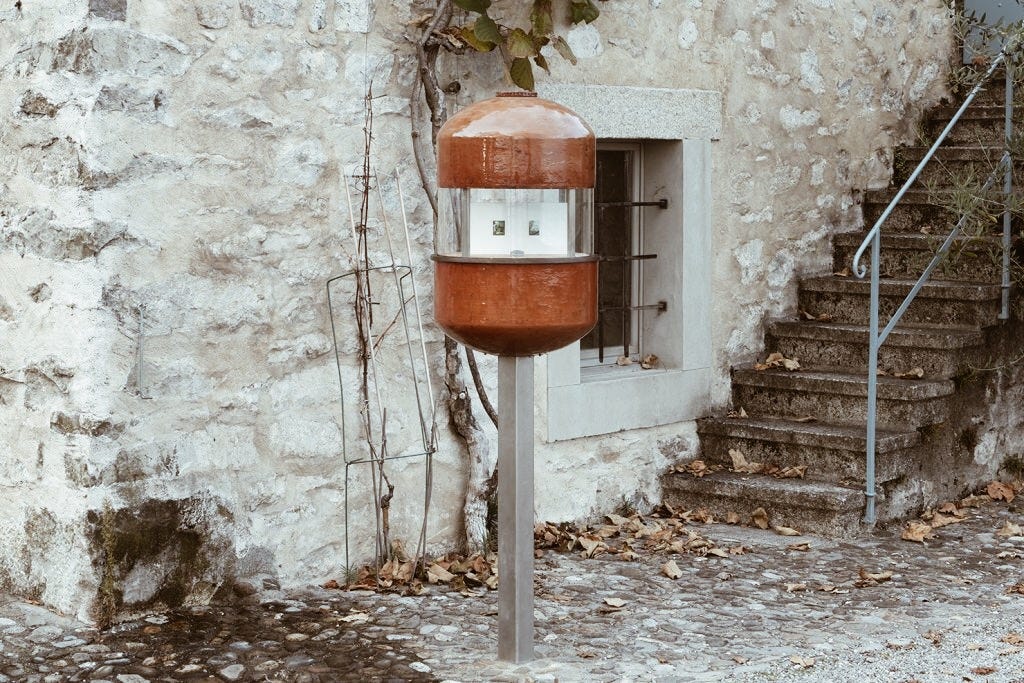Sp5 — Kunsthalle Marcel Duchamp
Cully | Welcome to the “smallest museum in the world” at The Forestay Museum of Art
WORDS BY MILES FORRESTER
At the base of a stairway cut from a stone wall in the village of Cully, Switzerland, is a glass enclosure resembling a large mid-century pill, balanced on a thin steel plinth. Inside, at the time of writing, is a diptych of symmetrical ears in acrylic under glass. In the right ear (our left) is a butterfly at rest beside the canal's entrance, with wings like inverted auricles. Third Ear by Sarah Margnetti is 16 x 24 cm, but because of its miniature setting in the Kunsthalle Marcel Duchamp (KMD) at The Forestay Museum of Art, it imposes itself on any passerby who stoops to view it.
KMD was founded by Swiss artists Caroline Bachmann and Stefan Banz in 2009, to commemorate a conference of Duchamp research. The Forestay river bears special significance, as its waterfall is the setting of the Dadaist Duchamp’s last work, Étant donnés: 1° la chute d'eau, 2° le gaz d'éclairage. Created secretly over 20 years during his supposed retirement, and only mounted after his death, the installation (housed in the Philadelphia Museum of Art) is composed of a large wooden door set within a brick facade. Through two peepholes, the viewer can see an assemblage of found, painted, photographed, and mechanical elements depicting a nude woman reclining in the grasses before the museum's namesake falls.
The encounter is a prevailing theme through Duchamp, and it's also the ethos at KMD. As well as publishing several editions of scholarship on Duchamp and his milieu, the KMD has exhibited the small works of 50+ artists, including Ai Weiwei, Cildo Meireles with Antoni Muntadas, and Haegue Yang. Placing modest pieces en plein air in a relatively remote village allows the art to regain a strangeness that larger institutions invariably tame. There is no collection: the works come, and are gone with the next season.
CAN | You call the KMD “the smallest museum in the world.” How did this project begin?
CB ── Stefan Banz, my partner, who created the Kunsthalle Marcel Duchamp with me, passed away one year ago. He was really the main brain and person to organize it. It all began when we came to live in this village on the shore of Lake Geneva. We are both artists and were working together at that time. We were doing research for this one project, and we found out that the famous Forestay Waterfall is four kilometers away from where we were living─where I am still living. We took photos and it was so incredible.
Stefan sent everything to Michael Taylor at the Philadelphia Museum of Art, a sometimes director for modern art. He knew nothing about the waterfall, and so he came to Switzerland one week later. He fell in love and did a lot of research. At the end of the trip he told us, “You must absolutely make a symposium about that, so everyone researching Duchamp can see this waterfall and know about it.” That was in 2007, and in 2010 we realized the symposium with the help of a lot of brilliant Duchamp specialists.

CAN | What inspired the name Kunsthalle Marcel Duchamp?
CB ── To found the symposium, we had to find money. To find the money, we had to found an association, and we gave the title “Kunsthalle Marcel Duchamp” to the association. We thought, “Oh, it wouldn’t be nice to have ‘Kunsthalle’?” We didn’t get a lot of money; it’s a very small village. So we bought one very small house we could afford. Because we didn’t actually want to work in the kunsthalle, we asked a young architect if she could realize a small box that could function without us tending to it daily.
May 2010 was the first exhibition, with Ecke Bonk, whose work and research is, of course, completely related to Duchamp. The first exhibition of the symposium was meant to last one month. It’s been 12 years.
CAN | The museum is very public, but the location is fairly remote. What sort of traffic does it get?
CB ── The museum is on the shore of the lake and on the promenade where everybody’s coming and going: children, old people, young people─everybody. That said, not a lot of people initially attended the exhibition openings because the village is far away, but we always organized a dinner for 20–25 people. It was a very nice moment together, more like a meeting between friends. It took a very long time before people realized what it is. But now the village has taken it very seriously as a part of the identity of the place. At the beginning, we had no description text, nothing─just the box. But we realized that was a little bit frustrating for people. So now we have a small panel where we explain who the artist is and what the work is about, just to make it more accessible.
CAN | With the display being so out in the open, are you at all worried about vandalism or graffiti?
CB ── Sometimes yes, because there’s a very big jazz festival here, so there are thousands of people who come for that, and sometimes they are drunk. We had an incident once, but it was really not so bad. Until then it was no problem. But sometimes I worry, yes, a little bit (Laughs).






